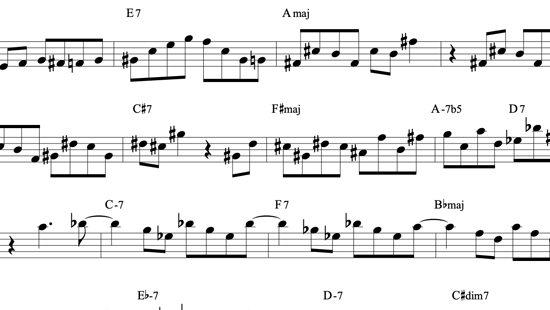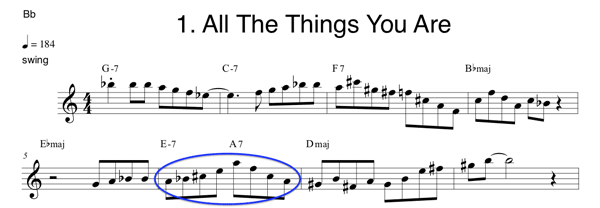Breaking Down a Jazz Standard to Create New Improvisational Vocabulary

I’d like to dig into two concepts to help give you something that you can try out for yourself, today. The first idea is great for beginner/intermediate players, the second is a more advanced idea.
Let’s look at the beginning 8 measures of the etude on All The Things You Are (Bb version):

Take a look at measure 6. The changes here are E-7 A7, which resolves to D major in the next measure. This is a typical short major 2-5-1, a progression that you will find in many tunes. One concept that can be useful in this situation is to ignore the 2 chord (E-7), and only play the 5 chord (A7) for the entire measure. Next, a great way to add more color and harmonic depth to your solo is to find some alterations that you can use on the 5 chord. In this case, I am using the b9 (Bb) and b13 (F). Then I resolve to the #11 (G#) on the D major chord.
You can practice this concept in a couple of ways. First, you can take the specific line that I play in measure 6, learn it in multiple keys, and try to play it on a tune that you are working on that also uses a short 2-5-1 (this also sounds great on a short minor 2-5-1). This process helps add a specific piece of information to your vocabulary, which expands your options while improvising.
Taking a “Detour”
Next, you can take the concept I’ve presented (thinking the “5 chord” for the whole measure, and adding alterations) and come up with your own lines. Have fun, and be as creative as you want!
Next, let’s look at a section during the second chorus of this etude:

The way I think about this line is that I take a detour through the chord changes. This can be an interesting way to add more color and dissonance to your lines. Here, I play many notes that are not theoretically in a C-7 chord or scale, but the way I resolve the line allows the ear to process this information as “sideslipping” or a “moment of suspense” before returning to familiar territory.
Much like when you take a detour in a car, you still want to arrive at a suitable destination, rather than aimlessly wander by playing random notes. Looking at the next couple of measures, I resolve on the root of the 5 chord (F7), then play an altered phrase over F7, and finally land on the #11 sound on the Bb major chord. One thing that is important to remember when using this sideslipping concept is that you must hear the “out” notes that you use. Playing random notes that you do not hear will give your solo a feeling of meandering, with little conviction.
Click here to download the entire etude in PDF format.
Thanks for reading, I hope you’ve found something useful and enjoyable, and with that I wish you happy practicing!





